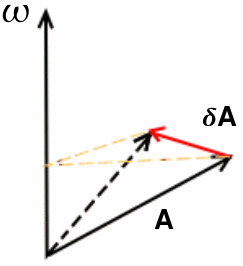Rotating frame transformation
From NMR Wiki
Rotating vector in a fixed frame
Let's start with a fixed laboratory frame. In that frame, imagine vector A rotating with a positive angular frequency ω. Direction of such rotation of A will be by convention - counter-clockwise.
Let's determine derivative  .
.
First calculate  - how much
- how much  changes within time
changes within time  :
:

In the equation above  - rotation angle,
- rotation angle,  - projection of
- projection of  on the plane normal to
on the plane normal to  , and
, and  - unit vector collinear with
- unit vector collinear with 
Notice that  is normal to the plane formed by
is normal to the plane formed by  and
and  .
.
Rotation angle can be expressed as

So, we have

Therefore:

Fixed vector in the rotating frame
If instead the vector is fixed in the laboratory frame, but the reference frame is rotating in the same direction and rate as above, our derivative within the rotating frame will simply equal above with the minus sign:



